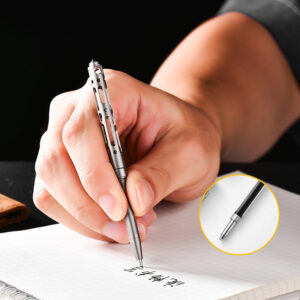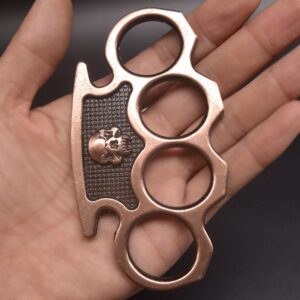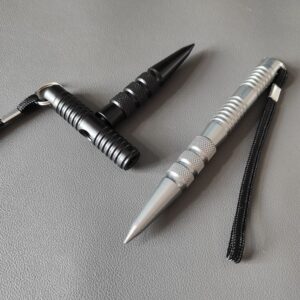No products in the cart.
Tactical Pen Maintenance: Cleaning, Lubrication, and Storage Tips
I. Fundamental Cleaning Procedures
Maintaining your tactical pen’s operational readiness begins with systematic contaminant removal, a process requiring meticulous attention to crevices where dirt, pocket lint, and moisture inevitably accumulate during daily carry. You should initiate cleaning by carefully disassembling components according to the manufacturer’s guidelines, typically separating the barrel, strike tip, ink cartridge, and threading mechanisms before using compressed air to blast debris from internal channels that defy conventional wiping. Subsequently, prepare a lukewarm detergent solution with phosphate-free soap (approximately 5ml per 500ml water) and employ microfiber cloths for scrubbing exterior surfaces while reserving cotton swabs for intricate threading areas, concluding with a thorough rinsing protocol under running water only if the pen explicitly claims waterproof construction—a step followed by immediate drying with forced air to prevent mineral deposits from compromising functionality.
II. Precision Lubrication Techniques
Once completely dry, strategic lubricant application becomes critical for preserving the tactile responsiveness of twist mechanisms and click assemblies, a procedure demanding judicious selection of specialist compounds like fluorinated grease (PTFE-based) for metal threading or silicone-based oils for polymer components applied via precision applicators to deliver minuscule quantities exclusively to contact points. You must particularly focus lubrication efforts on the threaded interfaces between sections, rotating components five times post-application to distribute compounds evenly while rigorously avoiding contamination of ink cartridges or ceramic breakers, since petroleum distillates will irrevocably degrade ink viscosity and compromise strike tip friction coefficients; consequently, quarterly maintenance cycles prevent galling in stainless steel interfaces while ensuring deployment mechanisms retain their authoritative tactile feedback.
III. Optimized Storage Protocols
Long-term preservation necessitates environmental control strategies that mitigate corrosion risks inherent to high-performance alloys like aircraft-grade aluminum or titanium, beginning with dehumidified containment in silica-gel-equipped storage tubes maintaining sub-45% relative humidity to preclude galvanic reactions between dissimilar metals. You should store disassembled pens in non-reactive fabric sheaths—preferably untreated cotton or microfiber—that permit passive ventilation while preventing surface scratches and neutralizing residual moisture through capillary action, positioning them vertically to prevent ink migration and component distortion; moreover, avoid leather holsters whose tannic acids induce oxidation patinas on brass fittings despite their aesthetic appeal, instead selecting segmented storage solutions that isolate pens from keys or tools capable of inflicting impact damage during transportation.
IV. Functional Integrity Verification
Between maintenance cycles, conduct monthly operational diagnostics commencing with visual inspections for stress fractures near screw threads and clip anchors under 10x magnification, followed by deployment mechanism testing to quantify any deviation from factory-standard actuation force thresholds. You must verify cartridge performance through standardized writing tests on non-absorbent substrates that reveal ink inconsistencies while assessing striker retention by applying perpendicular pressure to ceramic tips—any detectable wobble exceeding 0.5mm indicates compromised retention threads requiring immediate corrective action; furthermore, establish baseline metrics upon acquisition including deployment speed, twist resistance, and clip tension against calibrated measurement tools to objectively evaluate degradation that subjective handling might overlook.
V. Material-Specific Care Considerations
Understand that alloy differentiation dictates nuanced care requirements: titanium components thrive under minimal lubrication owing to their inherent galling resistance whereas copper-alloy pens demand specialized anti-tarnishing compounds to combat verdigris formation. You should accommodate coating vulnerabilities by avoiding alkaline cleaners on DLC (Diamond-Like Carbon) finishes and abrasive polishes on anodized surfaces, instead employing pH-neutral nano-coating sprays for ceramic-infused tactical finishes that preserve their non-reflective properties; additionally, extreme environment operators must implement preemptive lubrication cycles before desert deployments where particulate infiltration accelerates wear and immediately after saltwater exposure to displace chloride ions through controlled viscosity displacement techniques.
Maintenance Interval Reference Table
| Frequency | Critical Actions | Specialized Tools Recommended |
|---|---|---|
| Daily | Barrel exterior wipe | Microfiber cloth + Dry silicone wipe |
| Weekly | Mechanism actuation test | Digital torque gauge |
| Monthly | Full disassembly & inspection | Thread pitch gauge + Jewelers loupe |
| Quarterly | Lubricant refresh & storage audit | Precision applicator needles |
| Annually | Seal replacement & stress testing | Hydrostatic pressure chamber |
Pro Tip: Document maintenance dates on archival paper slips stored within pen cases—this creates a verifiable service history that significantly enhances resale value while identifying usage patterns affecting longevity.
By institutionalizing these protocols, your tactical pen evolves from disposable commodity to mission-critical companion, maintaining glass-breaking readiness, flawless writing performance, and structural integrity through years of demanding service. Invest twelve minutes monthly in these procedures to ensure your EDC defender never fails when exigency demands absolute reliability.











